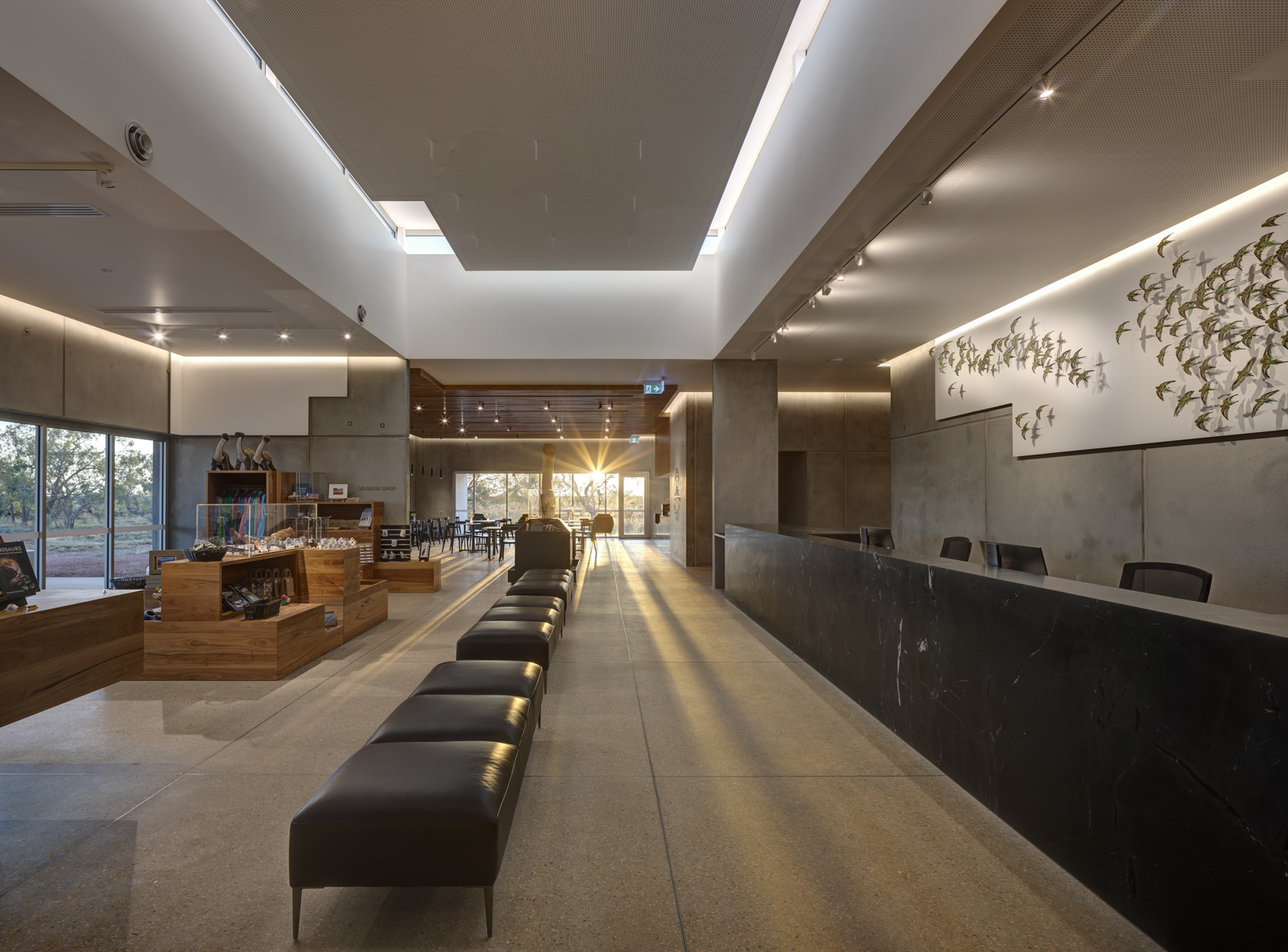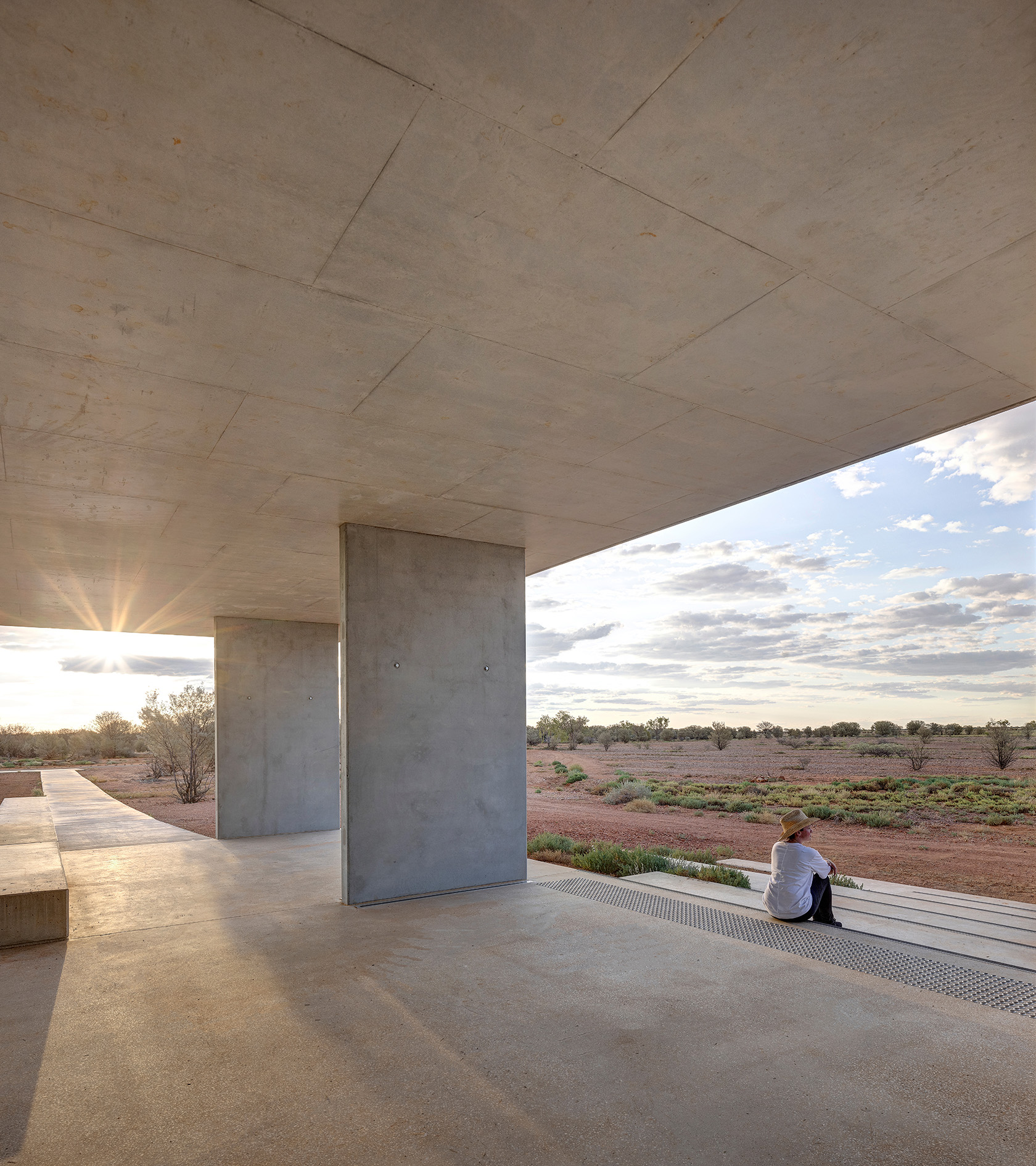
Designing a natural history museum
The Museum sits on Boonthamurra Country, on a low ridgeline with an existing foundation building and lodge to the south, Mulga to the west, a line of bloodwood trees at the interface of the ridgeline and an open plain to the east. To the north, the site looks out over gilgai and an open floodplain towards town.
The client had a clear vision for their Museum: they wanted a contemporary concrete building with enduring qualities and a design that would transform the space into a world-class natural history museum. Erring away from the classic red colour tones found in western Queensland, the client sought a building inspired by the washed-out, subtle tones found in black soil country, grass plains and vegetation. The building’s grey precast concrete walls have a subtle boarded concrete pattern that creates a softening effect of light and shade. The grey concrete sits beautifully in the landscape with its elegant, clean lines. The building heightens the experience of the surrounding landscape.
Visitors approach the Museum through a linear entry pavilion sitting beneath a dramatic concrete roof cantilevered from concrete blades. The pavilion aligns the approach to the building with views out to the stand of bloodwood trees. This view alignment was walked with the client and pegged out to ensure it was captured in the design. During the warmer months, the pavilion provides deep shade and a welcoming sense of arrival in the hot climatic conditions of Eromanga. In winter, the pavilion welcomes with a pool of sunlight and shelter from the cold, dry, southerly winds.
The first stage of the museum development is an entry building housing a reception, office, shop, café, theatre, gallery and courtyard. The grey concrete walls and honed concrete floor of the reception area are illuminated with the diffuse light of a clerestory high above and windows onto the entry pavilion. The reception area and café are scaled to accommodate guided tour groups commencing and completing their museum experience.
The café has two captivating views that are framed by deep sunshade elements. The first is a view towards the east and the stand of bloodwood trees. The second is out to the open plain to the north. An exhibition gallery leads visitors from the reception and café area to the theatre, where a film introduces them to the history of dinosaurs and megafauna in the area and the associated research activities. Visitors are guided through the Museum in small groups of 25. Visitors then move from the new buildings to the foundation building, where the bulk of the collection is stored.
A further stage, a research building, has recently been constructed to support the Museum’s research activities. There are three laboratories where fossils are prepared (by removing surrounding rock away from the fossil itself). There are also storage facilities for dinosaurs and megafauna fossils The building has been designed with temporary walls to allow for connection to the future main gallery space that is planned between the research building and the arrival building. The future main gallery will feature internal glazed partitions so that visitors can view the prepping laboratories and storage areas.
The next stage of the Museum development is to create the main gallery space located between the entry building and research laboratories. The gallery will be a dramatic column-free space featuring a full-scale replica of Cooper, which will stand 7 metres tall and span up to 30 metres in length. The replica will be illuminated by soft, diffuse natural light in combination with gallery lighting to create a memorable museum experience.

Working in a remote location
Collaborating with clients on a remote project is remarkably different to many city-based projects. Architectus has established a strong working relationship with the Museum staff, including members of the Mackenzie, Pegler and Richards families and the Quilpie Shire Council team, all of whom welcomed Architectus into the tight-knit local community. These close relationships generated ideas, aspirations and design responses.
The construction typology and materials for this project were carefully considered in response to the remote location and extreme climates. While off-form concrete was initially preferred for the project, the team decided to use pre-cast concrete for most of the building as it provided better quality control and ensured that concrete pours were not impacted by extreme weather. Pre-cast panel sizes were then carefully considered to minimise the number of trucks required to deliver the panels to the site. The Museum team were excited to see the first precast panels installed because they represented many years of planning and effort to secure funding for the project.
Architectus project lead, Stephanie Donigi, brought extensive experience to the project, in particular her learnings from working on the PNG National Museum & Art Gallery. Stephanie deeply understood the importance of designing and documenting remote buildings as a way of ensuring that construction would not be hindered by remote access, especially when trades needed to revisit the site on multiple occasions. The approach also involved developing a close working relationship with the contractor so that any issues raised on site could be dealt with efficiently while maintaining the design intent. The project builders, New State Builders, are proud of their work, and the project provided locals with the opportunity to upskill.

Environmental impact, cultural heritage, economic viability and social significance
The Museum’s remote location presented a number of sustainability challenges that were addressed in the design. Eromanga can experience temperatures below 0ºC in winter and close to 50ºC in summer. The building envelope is designed to insulate from these extreme conditions with a build-up of pre-cast concrete panel externally, air gap and insulation and internal concrete panel. External glazing is minimised, but where it occurs, high performance glazing is used to reduce glare and heat load. With no air conditioning running, the envelope creates internal conditions that are significantly cooler than external conditions on a hot day and in winter, the building does not need to be heated.
The mains power supply available to the site is limited, which resulted in the need for a high performing building envelope and the need to carefully consider the type and context of electrical and mechanical services within the building. The new building features a rooftop solar array to supplement the power supply. The Museum hopes to create its own solar farm so that it can access a self-sufficient power supply.
The new building maintains a self-imposed 15-metre clearance from the stand of bloodwood trees. Overland flows were also considered to ensure that during rain events the stand of trees continue to receive water running off the ridgeline.

A piece of history
The Eromanga Natural History Museum is a simple yet elegant design of enduring quality. It is a confident concrete form that sits comfortably in its surrounding landscape. The design of the building enhances the visitor experience and provides a supportive and inspiring work environment for staff and volunteers.
Architectus is proud to be helping the Museum realise its dream of becoming a state-of-the-art natural history museum with the future development of the main gallery space.
Team acknowledgments:
Rachel Cox, Joe Feng, Morgan Lui, Kaela Wallace, Peter Grealy, Greg Allis, Mark Hogan.


